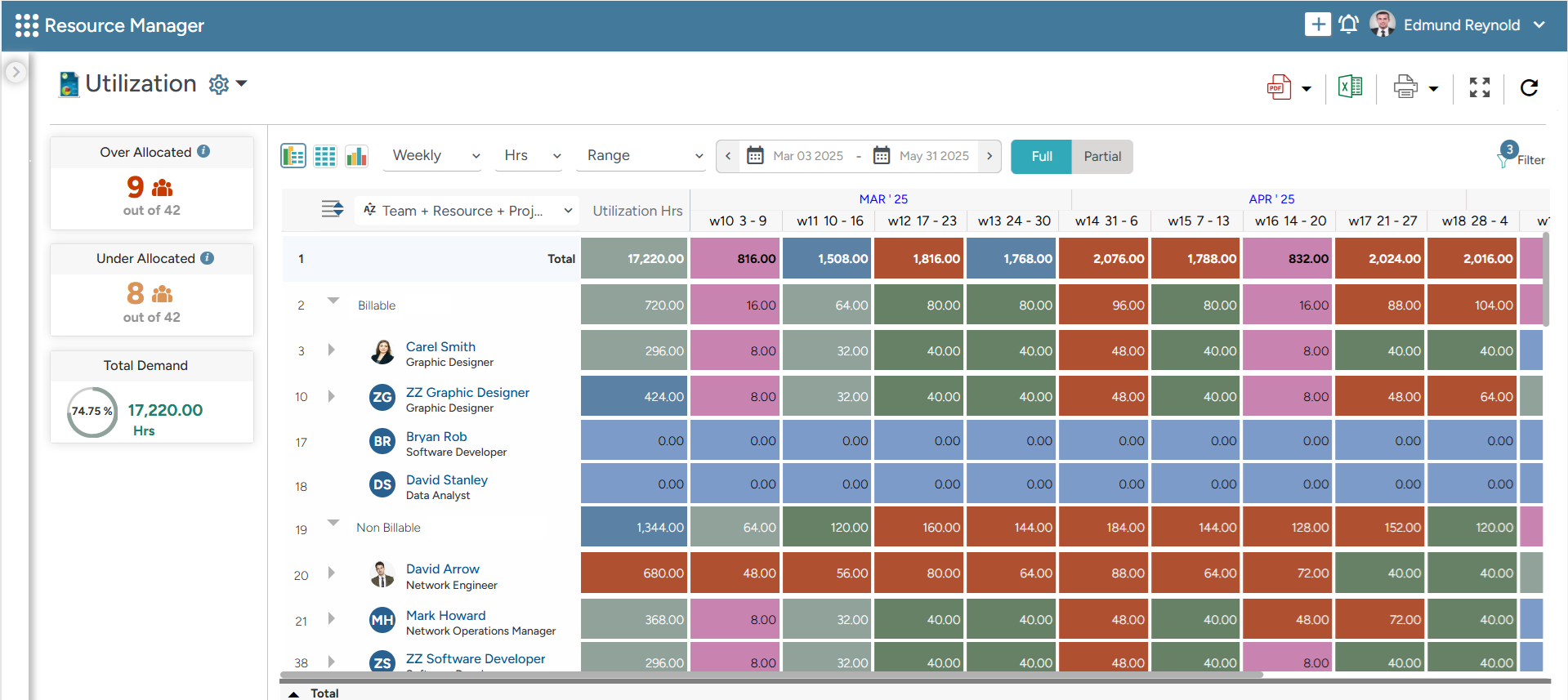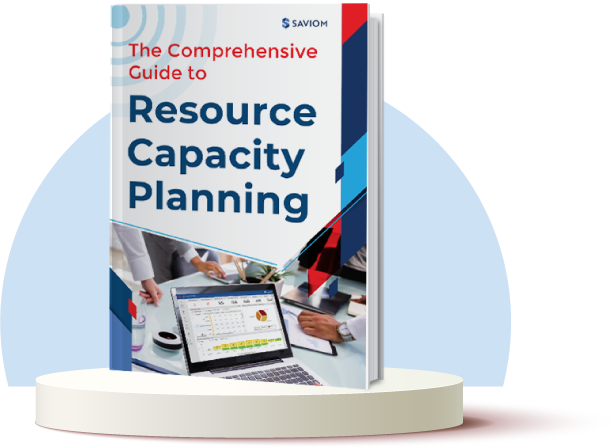In a dynamic work environment, ad hoc tasks are inevitable. However, complications arise when managers realize that a significant portion of team members are unavailable to take on the task. This can lead firms to assign this one-off task to resources already booked to their full capacity. Consequently, it leads to resource overutilization, burnout, lower productivity, subpar deliverables, etc. Here is where resource-constrained scheduling comes into the picture.
It enables managers to adjust the project schedule to align with resource availability, ensuring that the critical tasks are completed on time without overloading any resources. Thus, managers can enhance workforce productivity, prevent resource burnout, and ultimately lead to quality project outcomes.
In this blog, we will see what resource-constrained scheduling is, its benefits, and key steps to apply it to a project.
Let’s begin.
What is Resource-Constrained Scheduling?
Resource-constrained scheduling is the technique that involves adjusting the start and end dates of a project with a flexible timeline to account for the limited availability of resources. Besides, the goal is to balance resource demand with available supply to realistically meet project deliverables without overburdening the team.
Read More: Getting Resource Leveling Right for Projects
Next, let us see a few instances where resource-constrained scheduling can be used.
When to Use Resource-Constrained Scheduling?
Here are a few instances to use resource-constrained scheduling:
Limited Availability of Resources
When an organization faces limited resource availability due to unplanned attrition or sudden leaves, resource-constrained scheduling becomes a useful tool. Here, managers can prioritize projects based on their business value, analyze their critical path, identify task interdependencies, and strategically deploy these limited resources to ensure successful project execution.
Multiple Projects Sharing Resources
In large organizations, multiple projects run simultaneously and often rely on a limited pool of critical resources for their completion. This can lead to some resources working way beyond their capacity. To avoid this, firms can use resource-constrained scheduling to identify and assign these niche-skilled resources to high-value initiatives, optimizing their utilization levels & ensuring smooth delivery.
Read More: The Art of Resource Planning Across Multiple Projects
Budget Constraints
When a project has to adhere to a strict budget, managers can leverage resource-constrained scheduling techniques. They can adjust the project timeline to ensure the individual task schedule aligns with the availability of the team members of the existing team. This way, projects are managed realistically without increasing overall costs.
Flexible Project Timelines
When resources are finite and a project isn’t bound by strict deadlines, it makes sense to plan tasks around when your team is available. Instead of allocating excessive work to a few people, you can shift task dates to make things more manageable. This helps firms maintain an optimal resource health index and ensure streamlined project workflows.
Read More: 12 Essential Project Management Principles for Successful Execution
Let us understand the concept better with an example.
Example of Resource-Constrained Scheduling
Consider this scenario: In a high-rise construction project involving a 20-story building complex, tasks like structural framing, material lifting, and HVAC setup are all lined up for various project stages. However, the issue is that only two certified crane operators are available, and they are shared across three different work zones within the complex. Since cranes are crucial for heavy-lifting tasks, their unavailability directly impacts when certain work can happen.
To address this, the chief engineer adjusts the task timelines depending on when the crane operators are available. That is, instead of running crane-dependent similar tasks simultaneously across multiple work sites within the complex, they are staggered across zones. Thus, in areas where a crane operator is unavailable, the team can focus on other project tasks that don’t require lifting equipment. This way, resources in question are not overloaded and can deliver exceptional outcomes without compromising safety.
Read More: What is Resource Scheduling? How to Schedule Resources for Projects Efficiently?
Now, let us move on to the differences between resource-constrained scheduling and resource smoothing.
Resource-Constrained Scheduling vs. Resource Smoothing
Project managers can implement two significant techniques for resource optimization that lead to better project execution.
While we are now familiar with resource-constrained scheduling, resource smoothing is the process of adjusting the scheduling within the available slack time or redistributing workloads for optimum resource utilization. Given below are the differences between the two:
| Aspect | Resource-Constrained Scheduling (Resource Leveling) | Resource Smoothing (Time-Constrained Scheduling) |
|---|---|---|
| Definition | Resource-constrained scheduling is a technique that re-adjusts project dates to align with the available resources. | Resource smoothing is a technique that adjusts task allocation without overloading resources and without changing project deadlines. |
| Main constraint | Resource unavailability is the major concern. | The fixed project deadline is the main constraint. |
| When it is applied | To projects with a flexible timeline when resources are overloaded. | To time-sensitive projects with fixed start and end dates, when resources are overutilized. |
| Critical path | Can be modified | Remains rigid |
| Impact on Project Timeline | The project timeframe may extend due to resource unavailability | The project timeline remains constant. |
Now that we know the differences between the two techniques, let us move on to see the various benefits of resource-constrained scheduling.
Benefits of Resource-Constrained Scheduling
Here’s how resource-constrained scheduling makes a real difference when organizations work with limited people or tools:
Prevents Project Delays
When resources are limited, tasks often get delayed because the right person, equipment, or tool isn’t available at the right time. In such situations, resource-constrained scheduling can be used to adjust project timelines to align with employees’ availability. This ensures timely task initiation and keeps the project on track.
Read More: 7 Essential Steps of Project Integration Management: A Complete Guide
Minimizes Resource Overutilization and Burnout
In a project, when there is resource scarcity or when key resources are shared across multiple projects, there is a high chance of over-allocating them to work, leading to burnout. Resource-constrained scheduling helps avoid this by adjusting the project timeline based on the actual availability of that resource. This ensures balanced workload distribution, better resource health index, and improved productivity.

SAVIOM’s color-coded heatmap helps managers quickly spot instances of overutilization and take corrective actions promptly.
Keeps the Project Realistic & Feasible
By building the plan around real-time availability, resource-constrained scheduling helps keep things practical. It helps avoid overcommitting the team or setting deadlines that aren’t achievable. This way, even with limited capacity, the schedule stays realistic and feasible, helping maintain resource utilization at an optimum level and ensuring a steady project progress.
Helps Control Project Budget
When there are limited resources, every manager’s first thought is to hire extra resources, which can spike the overall project budget. However, with resource-constrained scheduling, firms can plan tasks around the resources they already have, i.e., current resource availability. Moreover, since the plan is more grounded in reality, your cost estimates also stay closer to the actual planned budget.
Read More: Project Cost Management: Types, Importance, and Steps to Calculate It
Now that we know about the benefits of resource-constrained scheduling, let us take a look at some of the disadvantages.
Disadvantages of Resource-Constrained Scheduling
Resource-constrained scheduling helps in many ways, but it can also make parts of the project harder to manage. This is how:
Restricts Project Flexibility and Extends Timelines
In resource-constrained scheduling, timelines often get extended to align with limited resource availability. However, these new dates can overlap with existing priorities, making it harder for resources to effectively contribute when needed. Moreover, when tasks need to be completed solely based on resource availability, it leads to a rigid schedule. This often results in less room to adapt if unexpected changes arise.
Alters the Critical Path
When projects are rescheduled based on resource availability, the original sequence of dependent tasks often changes. This can disrupt the critical path, i.e., the shortest route to project completion. The problem arises when minor changes in task sequence cause serious delays, shift priorities (making non-critical tasks suddenly critical), and stretch the overall timeline.
Read More: Top 14 Project Management Methodologies: Tips to Choose the Right One
Complicates Resource Scheduling
Adjusting the project timeline based on resource availability can make the scheduling process more complicated. This is because tasks must wait for the availability of the right resource, even if they’re due to start. However, since many resources are already tied to other work, it’s harder to shift tasks promptly. Also, there’s less room to swiftly re-shuffle things, which disrupts the overall schedule.
Disrupts the Flow of Activities
In resource-constrained scheduling, tasks are no longer executed in their natural or ideal sequence. Instead, they’re arranged around when resources are free, which can break the planned flow of work. As a result, some activities may be paused midway or start later than planned, causing disruptions in the workflow. This hampers the momentum of the project and affects smooth task transitions.
Read More: What are Project Interdependencies & How to Manage them Effectively?
Now, let us see how to apply resource-constrained scheduling in a firm.
How to Apply Resource-Constrained Scheduling?
To keep things on track, managers need to know how to make the most of resource-constrained scheduling. Here are a few steps to help guide the process:
Identify Resource Constraints
Managers need to first identify what resources are available, on what days, and for how many hours. For this, they can review resource calendars, current and future allocation, planned time-off, etc., to know the resources’ availability. At this stage, the focus is on understanding the actual workforce limitations.
For example, if the UI designer is already committed to another product launch, it can directly influence the contested project’s workflow. The point is to avoid stretching anyone too thin and stick to what the team can actually handle. It helps you set clear expectations from the start and keeps the plan realistic.
Outline Task Dependencies and Priorities
Once resource constraints are understood, managers can begin outlining task dependencies and setting priorities according to the availability of resources. This involves identifying how tasks relate to one another, what needs to be completed first, and which tasks can run in parallel.
To outline these, managers can use simple tools like Gantt charts or task boards to visualize the order of activities. They can further group related tasks and identify those that are critical to delivery timelines. For instance, the development of the website must be completed before testing begins, so priorities should be set accordingly.

SAVIOM’s Gantt Chart helps users manage tasks, project timelines, deliverables, and resource allocation effortlessly from a single, unified platform.
Assess Resource Availability
To plan realistically, managers need to take a closer look at how much time each resource can spend on the upcoming work. This means checking their existing workload, capacity, and the type of roles they’re handling. Managers can also use advanced tools to check their data on a centralized platform and spot bottlenecks early.
For instance, if a business analyst is booked at 85% capacity across two high-effort projects, there’s limited room to assign them more without risking burnout or delays. By identifying this issue early on, managers can shift project timelines and raise concerns with stakeholders to keep things aligned.
Adjust Tasks Based on Resource Availability
Next, managers can start adjusting the task schedule based on the resource’s bandwidth for upcoming work. Instead of following the original plan, they can extend project timelines, aligning tasks to resource availability. This way, the project moves forward without overloading the limited pool of talent or causing employee burnout.
For example, if two key developers are fully booked during the project phase, their tasks can be rescheduled to the next available window, even if it extends the timeline slightly. This way, resources are not overwhelmed, and the work gets done properly instead of rushing through a packed schedule.
Continuously Monitor and Adapt the Project Schedule
Once the project is underway, managers need to stay on top of progress. It helps to check in regularly, see if tasks are still on schedule, if anyone’s suddenly less available, or if new roadblocks have arisen. Even small delays or shifts in team dynamics can affect the overall flow.
Further, to keep things in check, managers can hold weekly check-ins or use tools like Gantt charts for real-time updates. If resource-centric bottlenecks arise or timelines shift, managers can adjust task sequences and extend deadlines as needed to keep the project on track and minimize disruptions.
Now, let us move on to see how a next-gen tool helps with resource-constrained scheduling in project management.
How Can a 5th Gen Resource Management Tool Help?
Advanced resource management software helps managers implement suitable optimization techniques like resource-constrained scheduling and build a competent talent pool, improve project outcomes, and reduce costs. Let’s explore how it works:
- The all-in-one resource planner offers a multi-dimensional analysis feature, which enables managers to view resources from various organizational dimensions such as skills, competencies, availability, cost, etc.
- The embedded heat maps offer real-time insights into resource utilization levels, enabling team leads to pinpoint overloaded employees.
- With intelligent matchmaking, managers can identify resources based on their skills, competence, availability, capacity, etc., and allocate them to the right projects/tasks.
- The tool’s smart KPI forecaster offers managers real-time insights into key resource metrics like capacity, availability, utilization, etc. These insights aid managers in making informed scheduling decisions promptly.
- Beyond this, the task management feature displays the start and end dates of tasks, which allows managers to align resources to suitable tasks based on their availability.
- With its business intelligence capabilities, managers can analyze various resource metrics, including availability, workforce utilization, etc., and address variances.
- The what-if analysis function enables managers to simulate various scheduling scenarios with limited resources, aiding in better resource planning and successful project delivery.
Conclusion
Resource-constrained scheduling helps streamline project workflows when availability is limited. It helps managers align project goals with available capacity to ensure smooth execution without overloading teams. This ensures optimal employee productivity, effective delivery of project deliverables, and improved top and bottom lines.
So, how often do you implement resource-constrained scheduling at your organization?
The Glossary
Read More: Glossary of Resource Workforce Planning, Scheduling and Management










